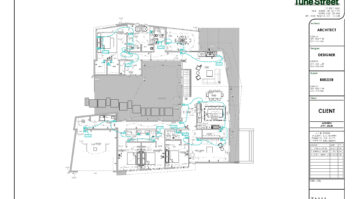Last week I met with a prospective client in her home. She has an older audio/video system and wanted to look at doing a “refresh” by adding in streaming video and a new control system. While talking with her, I asked if I could see how the system currently operates so I could understand her pain points and what she liked about the current usability.
When my client pressed “Watch CableTV” on her older remote, unsurprisingly, the “no signal” message came up on the TV because the cable box was powered off. I asked her if there was a power button for the cable box on her universal remote. Her response was so creative that I was stunned. She said, “No, but I just push this button that says ‘no signal,’ and it fixes the problem.” How brilliant is that?!

RTI Play-Fi control
When was the last time you got a call from a client who said “my cable box isn’t on”? I bet never. But how many calls come in where the client tells you “my TV says no signal”? I bet that happens quite a lot. So why have we been putting a button on the remote that says, “cable power”? The client doesn’t know what to do with that. But a button that says the exact symptom they are experiencing? That’s a no-brainer! You can be very certain that we will be programming a “no signal” button onto all remotes for cable boxes, Samsung Blu-ray players, and any other device without discrete power.
We have already been doing something similar with the buttons for surround sound on a remote. We historically have put buttons for Dolby Surround and Multichannel Audio on remotes for all video sources. But it took time to explain it to clients, and even then they barely got it. Now we have buttons that say, “Speakers—Movie” and “Speakers—Music,” and the questions are almost totally eliminated when we hand over the interface to the client.
This got me to thinking of other ways we talk to clients in words that don’t make sense to them, or that don’t address their issue clearly. I’ve come up with a list of terminology we are actively trying to replace or alter in our discussions with clients:
Home Automation. I can’t tell you how many times I have to explain what home automation means. “Automated lighting and shading, controlling your thermostat when you’re away from home, setting schedules so things happen automatically, etc.” I’ve started saying, “smart home” recently, and now clients’ eyes don’t glaze over. Instead, they light up, and they immediately get what I’m talking about and are excited about the prospect. The conversation quickly turns to, “What cool things can we do?” instead of us trying to sell them on a concept that they think is overly complicated.
Whole-Home Audio. This terminology just sounds too technical and takes clients a few beats to really put it together. Now I just say “music in every room” or even easier, I’ve begun telling them that we are putting in Sonos and asking which rooms they want it in. Sonos has built such solid brand awareness that it often doesn’t take much explanation.
Enterprise-Grade Networking. Clients are already scared of networking, so adding the words, “enterprise-grade” just makes it even more intimidating. Now when I say “reliable and fast Wi-Fi everywhere in the home,” they are nodding their heads yes before I can get the words out of my mouth.
Streaming Video. For something as simple (and unprofitable) as an Apple TV or Roku, it often took a lot of discussion and explaining to clients when I would say the brands of the streaming device. They would get hung up on Apple or Roku (if they even knew what Roku was) instead of how they will use the device. Now we simply ask, “Do you use Netflix or any other online video sites like Amazon Video or Hulu?” Based on their answers and the computing hardware they have (PCs or Macs), we put the appropriate streaming device into the proposal and don’t really even discuss it during the consultation.
I have found that talking to clients in the terminology that they use, instead of the terminology we use, makes us more approachable as a company and industry, makes the client more comfortable and less intimidated during our meetings, and leads to better buy-in when the proposal is presented.
How else have you used more client-friendly terms, either in discussions or as solutions on control devices (I’m still shocked that I had never thought of or seen the “no signal” button before!)?






